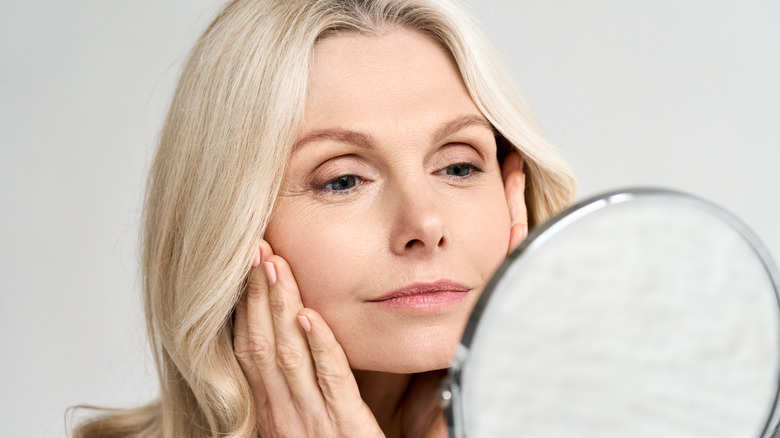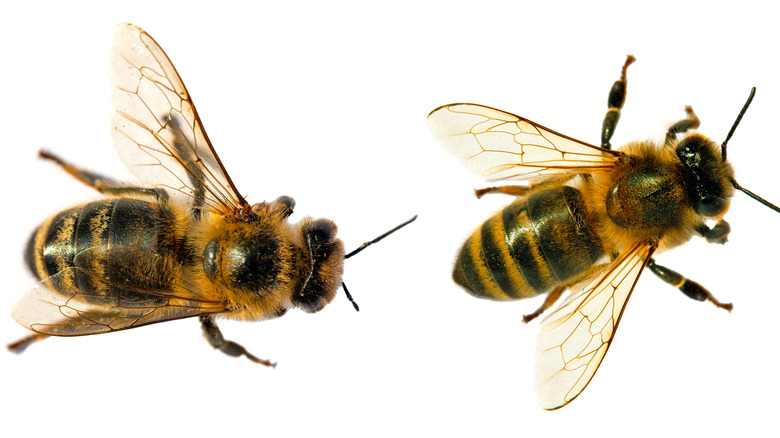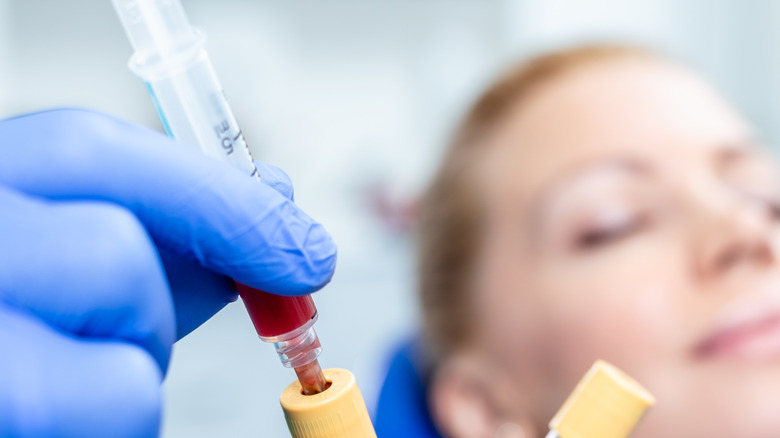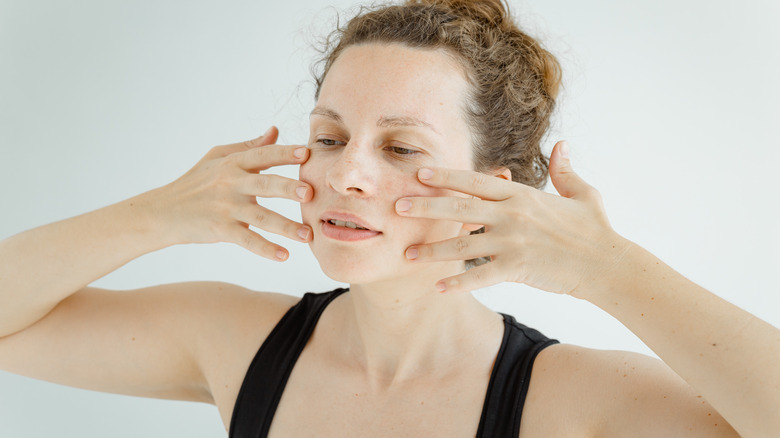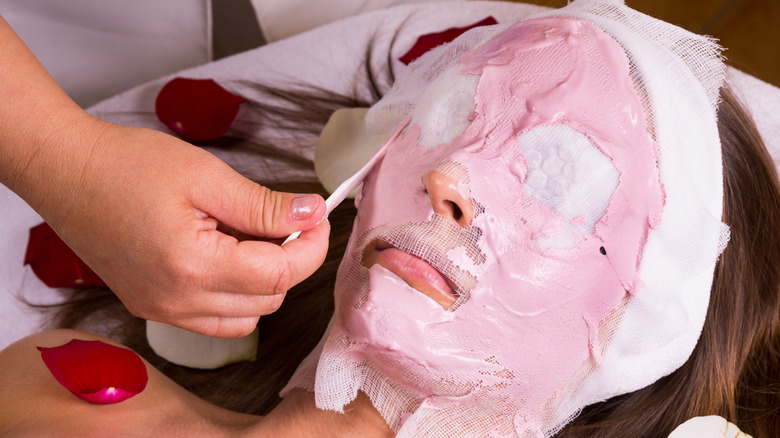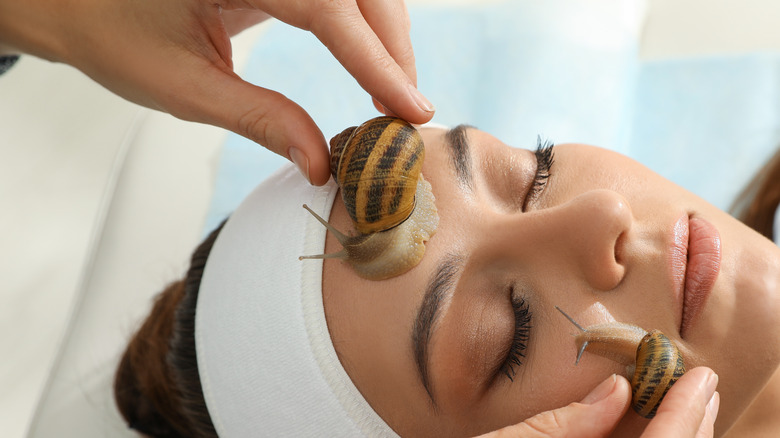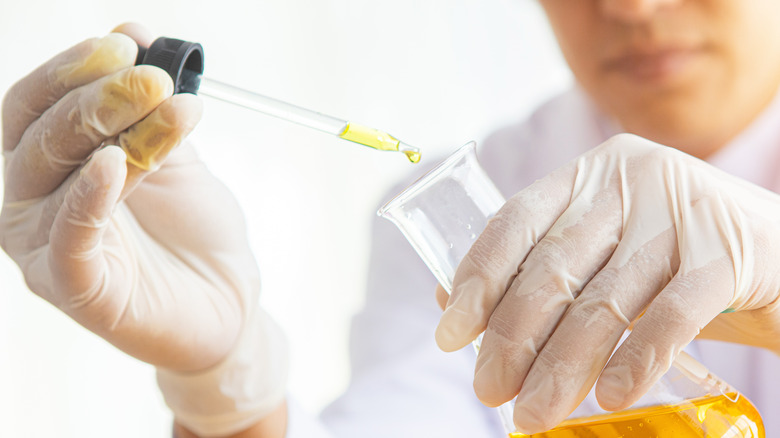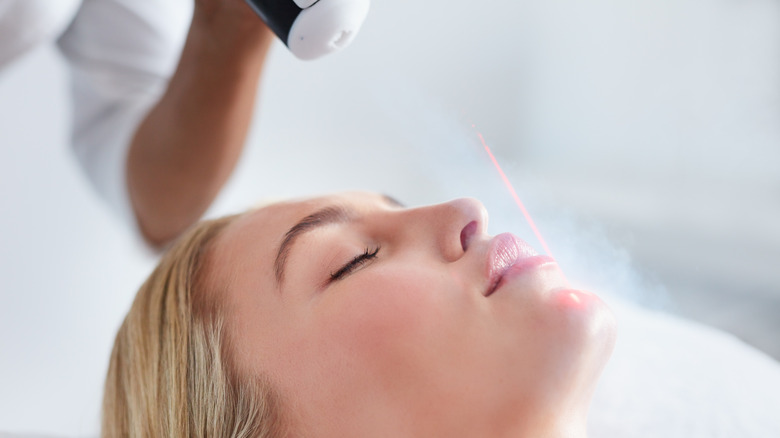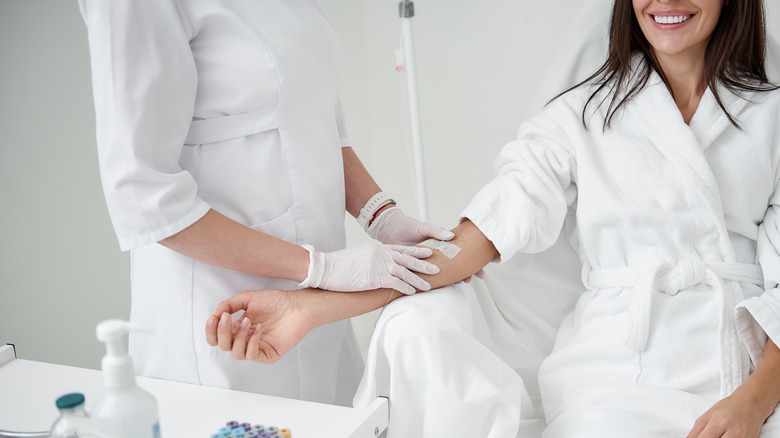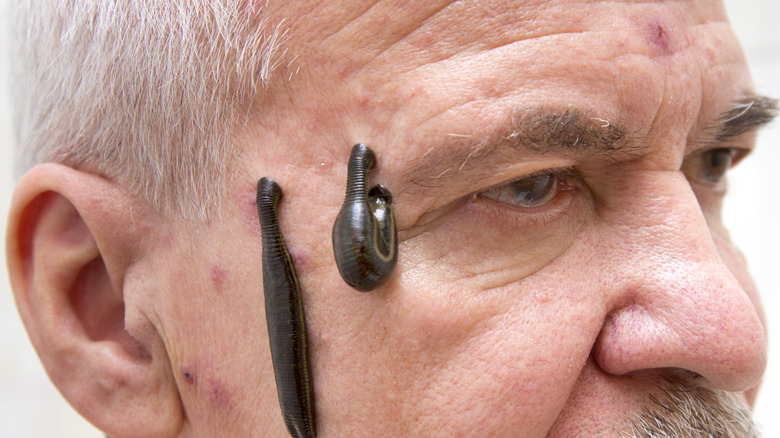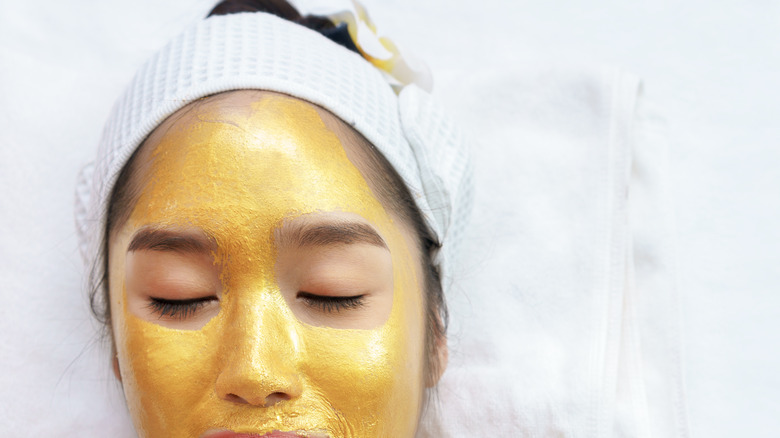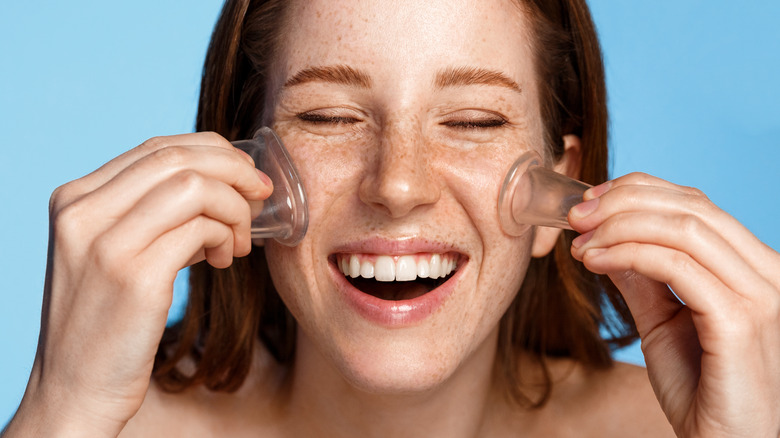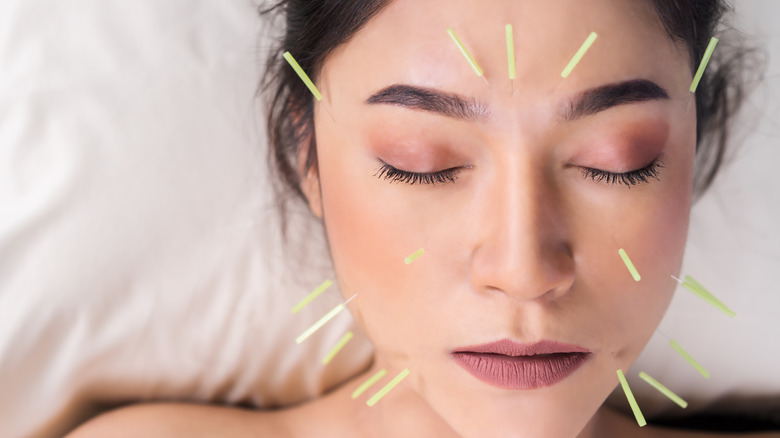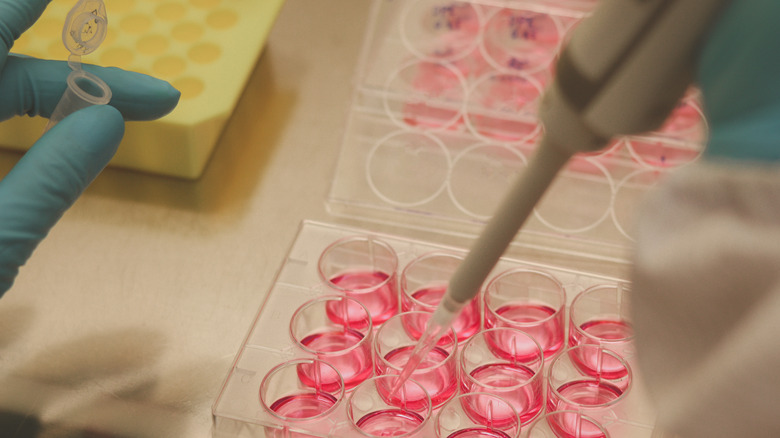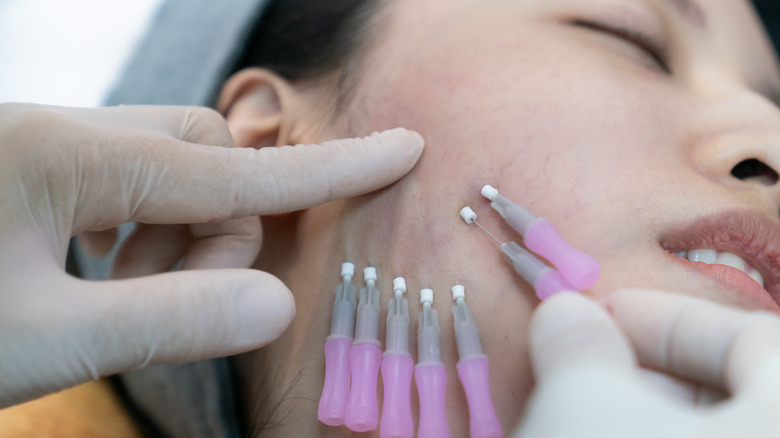Bizarre Anti-Aging Treatments You Might Want To Try
Whether you're young and want to delay the aging process as long as nature allows, or if you're already showing signs of aging and want to reverse them, there are plenty of tools and treatments to help you do just that. According to a report from Research and Markets published by Global News Wire, the global anti-aging market was set at $194.4 billion in 2020, and is expected to grow past $422.8 billion by 2030. An increase in medical tourism, as well as an increase in anti-aging cosmetic procedures, are among the factors contributing to this growth.
Some experts, however, believe that social media has played a role in the growing interest in altering our appearance and have spoken out. Elaine Ducharme, a licensed clinical psychologist in independent practice in Glastonbury, Connecticut, spoke to Healthline and said: "Social media plays a huge role in impacting self-esteem and [the] drive to alter our bodies. Everyone is so connected to the 'perfect' images of celebrities on their phones, iPads, computers, etc. Mixed in with all the friend information on websites such as Facebook, are all kinds of images and ads on how to look more beautiful." Whatever the reason, the world's interest in reversing the clock is only growing. If you're curious to experiment with the latest trends, continue reading to discover some of today's more ... unconventional approaches to anti-aging.
Bee Venom
As if pollinating all of our crops and providing us with honey, beeswax, and pollen weren't enough, bees have taken on another role to help us humans in our quest for beauty. Don't worry — you don't actually have to go around stinging your face with bees to get the results. Thanks to science, bee venom has actually been infused into topical products to help plump your skin without the sting. Maria Hatzistefanis, founder of skin care line Rodial, which carries its own bee venom product, spoke to InStyle and explained exactly how it works: "The bee venom itself increases blood circulation, gently plumping out and firming the skin, filling and smoothing fine lines and wrinkles. It also adds a rush of blood to the area and stimulates the production of natural collagen and elastin," she says.
Furthermore, a study published by Clinical Interventions in Aging trialed the use of bee venom serum on aging skin and found that it significantly reduced "total wrinkle area, total wrinkle count, and average wrinkle depth," concluding it may be an effective anti-wrinkle option. The study also noted that "the irritation potential of bee venom is negligible," so those with sensitive skin can benefit too.
Vampire Facial
This one has made the rounds on social media via certain celebrities for its gory look (via Healthista). A blood-stained face is a good reason to stop scrolling, all things considered. The "vampire facial" is clinically known as platelet-rich plasma (PRP) therapy, and is increasing in popularity due to its many potential benefits (via Healthline). During this procedure, some of your blood is drawn, and then your plasma is separated from your blood and re-injected into your skin. Marina Peredo, a dermatologist and an associate clinical professor of dermatology at Mount Sinai Hospital in New York City, spoke to Allure and explained how the therapy contributes to anti-aging: "The injection of PRP releases platelets, which are growth factors, into the cells, which stimulates collagen, helping the skin to look tighter and heal within." Beverly Hills-based dermatologist Ava Shamban spoke to the publication as well, and added that the therapy also "stimulates cell turnover," which is an additional anti-aging benefit. Furthermore, a study published by JAMA Dermatology tested the effectiveness of PRP injections on the improvement of texture and color of photodamaged skin and found that "both fine and coarse texture improved significantly more with a single treatment of PRP than with normal saline."
Face Yoga
Downward facing dog, crow pose, and now ... upward facing brows? While the benefits of yoga on the body, mind, and spirit have been heavily documented over time, the use of this exercise practice as an anti-aging technique for the face has only recently gained popular attention. According to Healthline, face yoga is a combination of both massage and exercise that work together to release tension, stress, and worry, helping to relax your overall state of being, and as a result, your facial muscles, too. According to the site, face yoga can be used to specifically target certain areas of the face including frown lines and crow's feet.
Danielle Collins, the founder of Danielle Collins' Face Yoga spoke to Healthline and explained how it works: "Face yoga helps to lift and firm the muscles under the skin, which smooths lines and wrinkles. Massage helps to boost circulation, improve lymphatic drainage, and release tension. Acupressure techniques boost circulation and relieve stress, which can aid in preventing headaches, releasing sinuses, and enhancing the quality of your sleep." Furthermore, a study published by JAMA Dermatology found that women who practiced 30 minutes of the exercise daily over 20 weeks experienced "improved facial appearance."
Placenta Facial
Yep. It's exactly what it sounds like. Fortunately, however, as with bee venom, there's no need for extreme measures here. It's placenta extract – most often from sheep, but sometimes from humans or plants – that's being used in products such as face masks and creams and providing benefits to the skin (via Healthline). So exactly what benefits are these, you might be asking? According to Healthline, because the placenta is designed to transfer nutrients and oxygen to fetuses during pregnancy, it contains a high level of nutrients which can be delivered to the skin upon application. Furthermore, the website states that placenta contains a high level of antioxidants, so applying it to the skin can combat oxidative stress, which typically manifests as wrinkles, discoloration, and reduced elasticity.
A study published by Nutrients that evaluated the effects of pig placenta on women ages 40-59 confirmed that the placenta improved the skin quality of the women who had taken supplements for four weeks. Healthline reports that current applications of placenta include face masks, creams, and sheet masks, which often contain other beneficial ingredients to help improve the skin's appearance.
Snail Mucus
Garden pest, escargot ... fountain of youth? Like it or not, snail slime has officially made it onto the list of dermatologist-approved ingredients to help reverse the signs of aging. Again, there is no need to run out to your garden to start harvesting snails. The slime has been incorporated into facial creams, serums, and the like to give them an extra boost of skin-friendly benefits. Board-certified dermatologist Hadley King spoke to Women's Health about how this all works. She first explains that you'll likely find snail slime listed as "snail mucin" or "snail secretion filtrate" on ingredient lists. She goes on to explain, "It's made up of properties like glycoproteins, hyaluronic acid and glycolic acid, all of which have long documented benefits for the skin."
According to Healthline, hyaluronic acid — one of the star ingredients in snail slime — is a natural substance produced by the body that is found in largest concentrations in the skin, eyes, and connective tissues. It naturally binds to water, and its primary function is to help the skin retain moisture. Supplementing your skincare regime with hyaluronic acid like the kind found in snail mucus can help your skin stay hydrated, reducing the appearance of wrinkles and fine lines.
Urine Therapy
Get ready for a major paradigm shift, because the idea of peeing yourself just took on a whole new meaning. Believe it or not, the practice of urine therapy, otherwise known as urophagia, has been around for thousands of years (via Healthline). There are documents that show that the ancient Romans, Greeks, and Egyptians used this therapy to cure a variety of maladies.
For better or worse, there is no need to infuse your (or someone else's) urine in fancy creams, serums, or masks — everything you'll need for this therapy has been given to you freely by mother nature herself. To shed light on how it all works, dermatologist Whitney Bowe spoke to Refinery29 and explained: "I recommend and prescribe different concentrations of urea, one of the main components of urine, all the time for my patients. It hydrates the skin and helps exfoliate away dead cells, giving skin a brighter appearance, smoother texture, and a healthy glow. Urine also has minerals, salts, hormones, antibodies, and enzymes, some of which might actually benefit the skin." If you are feeling brave, the site suggests using urine as if it were a toner, by soaking a cotton round with it and applying it all over the face.
Cryotherapy
If the idea of being frozen in time appeals to you, this therapy might be right up your alley. According to Healthline, cryotherapy is the act of pumping liquid nitrogen over the face for two to three minutes with the goal of achieving "glowy, youthful, and even" skin. Also, good news for those who are on a budget: according to the site, cryotherapy is on the cheaper end of the spectrum when it comes to facials, averaging between $40 and $150 a treatment. So, what's the science behind it all? Healthline reports that the freezing temperatures used in the therapy increase the flow of blood and oxygen to the skin, which can make it appear brighter, tighter, and overall more healthy.
Additional benefits include the potential for exfoliation. Joshua Zeichner, director of clinical and cosmetic research in dermatology at Mount Sinai Hospital in New York City, spoke to Allure and explained that the cold temperatures in cryotherapy "Enhance exfoliation of dead cells on the surface of the skin and strengthen the skin as a whole," and "expose healthy, more radiant skin beneath." According to Healthline, results typically last up to three weeks, so touchups are recommended after three to five weeks.
IV Drips
The image of someone hooked up to a machine with an IV might be cause for alarm, but for those who would do anything for a youthful glow, it's just another day in the life. According to Health, while Americans have been taking supplemental vitamins since the 1940s, the approach to taking vitamins through IV drips is a relatively new one. Dr. Erika Schwartz, founder of the Manhattan-based wellness center Evolved Science, spoke to the website and explained: "Anyone who wants to feel and look their best can benefit from an IV infusion. The benefits are numerous: improved mental clarity, immune boosting and defense against viruses and flu, body and mind fine tuning, and even clearer, smoother skin (by supporting collagen production)."
While many celebrities have already joined the IV drip bandwagon (via Atlas Health Medical Group), experts warn that there are some things to take into consideration before jumping on yourself. Lauren Harris-Pincus, registered dietitian and nutritionist and founder of NutritionStarringYOU.com, told Health that: "By taking IV vitamins you are bypassing your body's normal digestive process that has built-in safeguards for absorption, meaning you could end up with too much of some things." The site recommends going to your doctor first, and only taking the supplements advised in order not to overdo it.
Leech Therapy
No longer just something you find hanging on you after emerging from questionable water, leeches represent a unique alternatiative in the world of beauty treatments. While the concept of using leeches for health concerns dates back to ancient Egypt, the use of leeches in the cosmetic world is somewhat new (via Healthline). According to the website, leeches are primarily used in plastic surgery and microsurgeries, and are prized for their secretions that act as anticoagulants, which prevent blood from clotting. Furthermore, a study published in Ancient Science of Life trialed the use of leeches on 27 patients to manage the skin condition eczema over a seven-day interval, and found a considerable reduction of symptoms by up to 54% on the patients. The study says that the natural chemicals released from the leech saliva have "anti-inflammatory, antibiotic, thrombolytic action," which can benefit the skin in several ways. In addition to these uses, Healthline also reports that leeches have even been used to treat baldness and hair loss due to their ability to increase blood circulation. Before you head to your nearest lake with a bucket, Healthline suggests making sure you do this treatment in a regulated environment to reduce the potential for bacterial infection.
Gold in Skincare
Taking a breather from things that squirm and sting, this is definitely one of the easier treatments on this list to get behind. According to Healthline, facial treatment centers are incorporating real, 24-karat gold into their treatments for its potential "anti-inflammatory and anti-aging properties." Dr. Peterson Pierre, a dermatologist with the Pierre Skin Care Institute in Westlake Village, California, spoke to the website and says, "Though scientific evidence is lacking, gold is thought to have powerful antioxidant, anti-inflammatory, and antibacterial properties." Not bad.
While Pierre seems to be more on the skeptical side, there are other experts who are more convinced in gold's ability to keep you looking young. Corey L. Hartman, a board-certified dermatologist and founder of Skin Wellness Dermatology in Birmingham, Alabama, shared with Shape magazine that "Gold is an antioxidant, and it can help protect against free radicals that accelerate the aging of the skin." He later mentions that its anti-inflammatory properties can be good for those who deal with acne and rosacea. Furthermore, according to Healthline, gold contains tiny nanoparticles that reflect light, giving skin a brighter, more shimmery appearance, which may make it look more youthful.
Facial Cupping
Facial cupping is another modernized tradition with ancient roots. According to WebMD, cupping was used in ancient Egyptian, Chinese, and Middle Eastern countries, with evidence that it was employed as early as 1,500 B.C. This particular method of facial cupping, however, differs from traditional cupping in that the cups used are "smaller and softer" (via Healthline). The cups work by suctioning the skin away from the deeper muscle layers, helping to promote circulation and a fresh, youthful look. Ananda Emily Reese of Reese Acupuncture spoke to Healthline and explained, "Over time this practice improves the complexion and diminishes fine lines and wrinkles."
Healthline tallied the benefits of cupping, which include increased oxygen flow to the skin, stronger skin and connective tissue, and a boost in collagen-producing cells. All of these things can lead to brighter skin, a reduction in wrinkles and fine lines, a more toned appearance, and more. The site explains that cupping is typically safe, but a few side effects may occur, such as "dizziness, lightheadedness, nausea, and cold sweats." If you're interested in giving it a try, cupping can be done at home with kits, or you can seek out a professional who is trained in acupuncture.
Acupuncture Facial
Facial acupuncture offers a new take on a classic tradition that also has roots in Chinese Medicine. Acupuncture itself is designed to treat a number of conditions including chronic pain, fertility issues, and even cancer (via WebMD). Facial acupuncture follows the same procedures as the acupuncture you are probably already aware of, and is believed to help skin look "younger, smoother, and all-around healthier," according to Healthline. For this treatment, you'll begin by getting a full-body acupuncture treatment, and the therapist will then move onto your face.
Amanda Beisel, acupuncturist and founder of SKN Holistic Rejuvenation Clinic, spoke to Healthline and explained why getting a full body treatment first is necessary: "If you were just going to put a large number of needles in the face and not the full body, this would result in energy congestion in the face." According to Healthline, the punctures made by the acupuncture needles create what are called "microtraumas," which stimulate the lymphatic system, collagen production, and give your skin an all-around glow. Treatments start at $25 and can go all the way up to $1,500 according to the site, but can be a safer alternative to plastic surgery.
Using Stem Cells
It might sound a little sci-fi, but this leading-edge therapy that has typically been used to treat major diseases is now being used to treat wrinkles. According to the Mayo Clinic, stem cells are the original cells of the body — the template cells, so to speak, that form what are called "daughter cells" that play more specific roles in the body. Dr. Michele Green, board-certified dermatologist in New York City, spoke to Dermstore and explained how the proteins and amino acids in plant stem cells can actually be used to help humans fight the aging process: "These signal the body's cells to rejuvenate and may result in younger-looking skin," she explained. She adds, "Stem cells naturally have antioxidant properties and they nourish skin cells which promotes cell turnover and increases collagen production." Experts at the site believe the use of plant stem cells is safer than human or animal stem cells because it eliminates the possibility of spreading disease. You can use plant stem cells by finding creams, serums, or other products that have been infused with them. However, make sure you're consistently using them, and be sure to find the right products that work for your skin type.
Thread Lift
Because minimally invasive treatments like Botox, fillers, and the like require much less downtime than traditional facelifts (via American Society of Plastic Surgeons), they may be more appealing to those who want to rejuvenate their appearance without a potentially painful or drawn-out recovery process (via WebMD). What if it was possible, however, to have the best of both worlds? Enter the thread lift. According to Healthline, the thread lift is a minimally invasive facelift procedure that uses a "medical-grade thread" that is tightened to pull up the face and give it a lifted appearance.
Compared to a traditional facelift, there is practically no recovery time for a thread lift, and the procedure itself can be done in roughly an hour. To conduct the procedure, the doctor will apply a local anesthetic to the skin and then insert stitches underneath the skin which "grab" onto the tissue underneath, triggering a healing response that leads to the production of more collagen. You can isolate areas of your face (such as the cheek, undereye, and brows) with the thread lift, or opt for threading multiple areas for a fuller lift. Healthline also explains that typical results from this treatment last anywhere from one to three years, as the material from the thread will be absorbed by the body.

